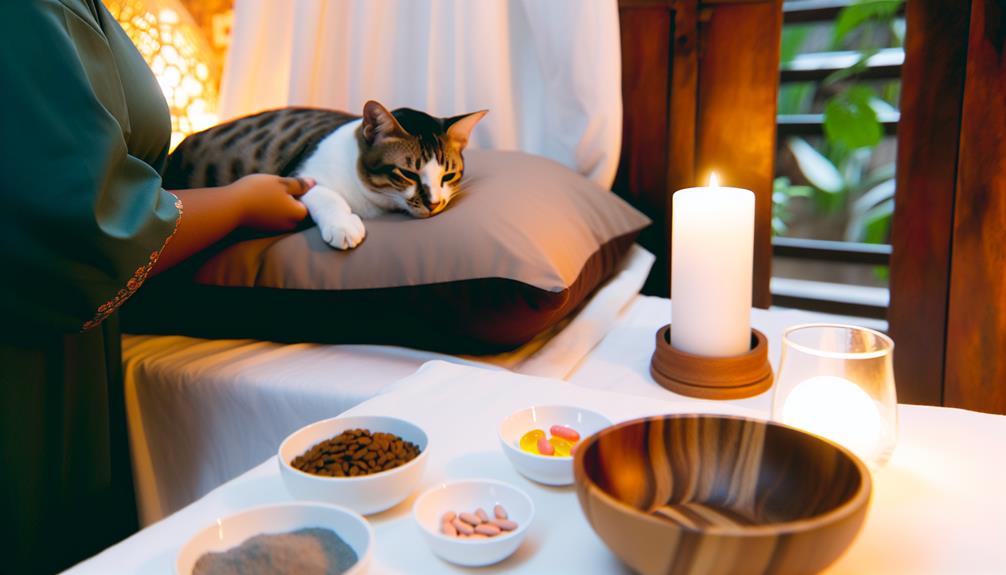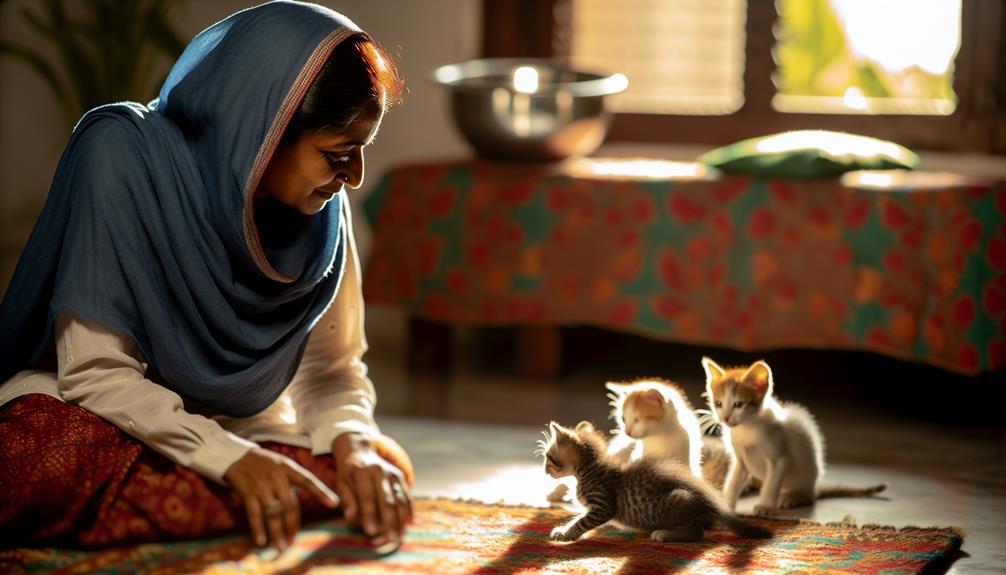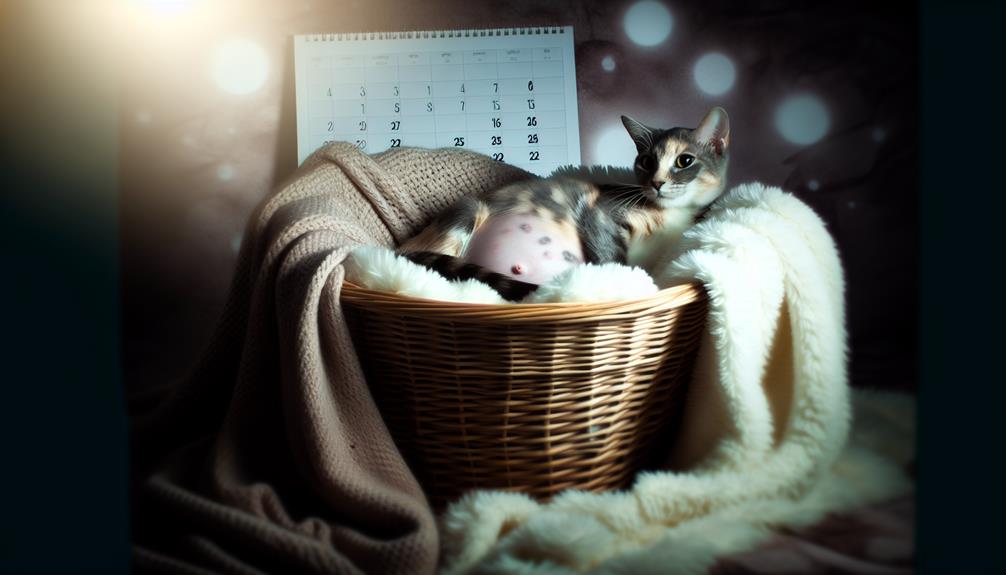When you think about cat pregnancy, consider its length, its stages, and its signs. Typically, cats are pregnant for about 63 to 67 days, but this can vary. During these weeks, a cat's body undergoes significant changes, and it's essential to recognize the signs and know how to support her. Understanding what to expect can help you guarantee a smooth process from conception to birth. Want to learn more about the stages of gestation and how to prepare for the new arrivals? Let's explore further.
Length of Cat Pregnancy
Understanding the length of a cat's pregnancy, often referred to as the gestation period, is important for any cat owner or breeder. Typically, a cat's pregnancy lasts between 63 to 67 days, though it can range from 58 to 72 days. This period is critical for feline reproduction and cat health, as it allows the developing kittens to reach full term.
You'll want to monitor the cat closely during this time. The gestation period is divided into three trimesters, each lasting about three weeks. During the first trimester, the fertilized eggs implant in the uterus, and the embryos begin to develop. In the second trimester, significant growth occurs, and you might notice physical changes in your cat. By the third trimester, the kittens are nearly fully developed and prepare for birth.
Maintaining ideal cat health during pregnancy is essential. Make sure your cat has a balanced diet rich in nutrients to support both her and her developing kittens. Regular veterinary check-ups are necessary to monitor the health of the mother and the progress of the pregnancy.
You shouldn't overlook the importance of a stress-free environment. A calm setting helps in reducing potential complications during the gestation period. Additionally, it's important to be aware of the expected due date to prepare for the kittens' arrival.
Signs of Pregnancy
During the early stages of a cat's pregnancy, you might notice subtle signs indicating that she is expecting. One of the first indicators is a change in feline behavior. Your cat may become more affectionate, seeking extra attention and comfort from you. Conversely, some cats might exhibit increased irritability. These behavior changes are often among the first clues that a cat is pregnant.
Another early sign is physical transformation. Around the third week of pregnancy, a cat's nipples may become enlarged and pink, a phenomenon known as "pinking up." This change is particularly noticeable if your cat has never had kittens before. Additionally, you might observe a slight increase in appetite and weight gain as the pregnancy progresses.
Nesting instincts often emerge as the pregnancy advances. Your cat may start to search for quiet, secluded spaces to prepare for the arrival of her kittens. She might gather soft materials like blankets or clothing to create a comfortable nesting area. This behavior typically intensifies during the later stages of pregnancy but can start earlier as well.
Vomiting can also occur during the early stages, similar to morning sickness in humans. If your cat suddenly starts vomiting without any other signs of illness, it could be an indication of pregnancy. However, it is crucial to consult a veterinarian to rule out other potential health issues.
Stages of Gestation

A cat's pregnancy is divided into distinct stages of gestation, each marked by specific developmental milestones. Understanding these stages is essential for anyone involved in feline reproduction, as it helps monitor the health and progress of the pregnant cat.
The first stage, known as the "fertilization and early development" phase, occurs during the first two weeks. During this period, the fertilized eggs travel to the uterus and implant themselves in the uterine lining. This is a significant time in the gestation timeline, as the embryos begin to develop rapidly.
The second stage, spanning weeks three to four, is referred to as the "embryonic development" stage. Here, the embryos develop their basic structures, such as the neural tube, which will later become the spinal cord. You might notice slight changes in the cat's behavior and appetite during this period.
The third stage, from weeks five to seven, is the "fetal development" phase. The fetuses' organs start forming, and skeletal structures begin to ossify. You'll likely observe a noticeable increase in the cat's abdominal size. This stage is crucial for the development of the essential organs and systems.
The final stage, weeks eight to nine, is the "preparation for birth" phase. The fetuses are now fully formed and just growing in size. The cat will show significant weight gain and may start nesting behaviors as she prepares for labor.
Preparing for Birth
As the final stage of gestation approaches, you'll need to start preparing for the birth. Breeding considerations should have already been addressed, but now your focus shifts to guaranteeing a safe and comfortable environment for your cat. One of the key behaviors to observe during this time is nesting behavior. Your cat may begin seeking out secluded, quiet areas to create a nest. This is a natural instinct and indicates that labor is imminent.
To facilitate this, prepare a nesting box. A simple cardboard box lined with soft towels or blankets will suffice. Place it in a warm, quiet, and dimly lit area away from household traffic. Confirm the box is large enough for the cat to move around comfortably but cozy enough to make her feel secure.
Monitor her closely for signs of labor, such as restlessness, vocalization, and increased grooming. Keep emergency veterinary contact information handy in case complications arise. It's also essential to maintain a calm environment, as stress can negatively impact the birthing process.
In terms of equipment, have clean towels, disposable gloves, and sterilized scissors ready. While cats generally manage labor without human intervention, being prepared for potential complications is wise. Understanding the stages of labor can further help you anticipate needs. The first stage involves contractions and can last up to 24 hours. The second stage is the actual delivery of kittens, and the third stage is the expulsion of the placenta.
Nutrition and Care

During your cat's pregnancy, you'll need to guarantee she receives essential nutrients, stays well-hydrated, and is in a stress-free environment. High-quality protein, vitamins, and minerals are vital for her and the developing kittens. Keeping her calm and comfortable will support a healthy gestation period.
Essential Nutrient Needs
Understanding the essential nutrient needs of a pregnant cat is critical for guaranteeing the health and well-being of both the mother and her developing kittens. A balanced diet rich in essential fatty acids and prenatal vitamins is fundamental. Essential fatty acids, such as omega-3 and omega-6, play a significant role in fetal brain and retinal development. They're also important for maintaining the mother's skin and coat health during pregnancy. You can find these in high-quality commercial cat foods specifically formulated for pregnant cats.
Prenatal vitamins are another key component. These supplements make certain that a pregnant cat receives adequate levels of vitamins and minerals, which may not be fully provided through diet alone. Folic acid, for example, helps prevent congenital disabilities, while calcium supports bone development. It's advisable to consult your veterinarian before introducing any supplements to guarantee proper dosage and compatibility with your cat's existing diet.
Additionally, high-quality protein sources should be prioritized to support the increased energy demands and the growth of the kittens. Opt for foods containing animal-based proteins, as they provide all essential amino acids necessary for peak health. By meeting these nutrient needs, you'll help guarantee a healthy and successful pregnancy.
Hydration Importance
Making certain your pregnant cat stays well-hydrated is crucial for her overall health and the proper development of her kittens. Adequate hydration supports essential physiological functions such as nutrient absorption, digestion, and temperature regulation. Dehydration can lead to complications and affect the health of both the mother and her unborn kittens.
To maintain ideal hydration, consider these hydration sources and tips:
- Fresh Water: Always provide clean, fresh water in multiple accessible locations throughout your home. Verify water bowls are cleaned daily to avoid bacterial build-up.
- Moisture-Rich Food: Incorporate wet cat food into her diet, as it has a higher water content compared to dry kibble, helping to increase her overall fluid intake.
- Water Fountains: Cats are often attracted to running water. A pet water fountain can encourage your cat to drink more frequently, thereby aiding in maintaining adequate hydration levels.
- Broth Supplements: Offering low-sodium chicken or beef broth can be a tasty and hydrating treat. Confirm it's free from onions, garlic, or other harmful ingredients.
Stress-Free Environment
In addition to maintaining proper hydration, creating a stress-free environment is crucial for your pregnant cat's well-being and the healthy development of her kittens. Elevated stress levels can negatively impact cat behavior and fetal health. To minimize stress, consider designating a quiet, cozy area in your home where your cat can retreat. This safe space should be away from high-traffic zones and loud noises.
Providing consistent nutrition tailored to pregnant cats is equally important. Opt for high-quality, nutrient-dense food and guarantee she has access to it at all times. Regularly monitor her weight and consult your veterinarian for any dietary adjustments.
Here's a quick reference table to help you create a stress-free environment:
| Key Aspect | Recommendation |
|---|---|
| Safe Space | Designate a quiet, cozy area |
| Minimize Noise | Keep away from high-traffic zones |
| Consistent Nutrition | High-quality, nutrient-dense food |
Understanding cat behavior during pregnancy will also help you address any stressors effectively. Pregnant cats often exhibit nesting behavior, so providing soft bedding materials can make her feel more secure. Additionally, gentle interaction and regular check-ups will help guarantee her comfort and health throughout the pregnancy.
Common Complications
Pregnancy in cats, while often progressing smoothly, can sometimes present several complications that require prompt attention. Understanding these pregnancy risks is vital for maintaining ideal feline health. Below, you'll find a list of common complications that may arise during a cat's pregnancy.
- Dystocia: This term refers to difficult or obstructed labor. It can occur due to several reasons such as an oversized kitten, malposition, or uterine inertia. Immediate veterinary intervention is often necessary to prevent harm to both the mother and the kittens.
- Eclampsia: Also known as milk fever, this condition is caused by low calcium levels in the blood. Symptoms include restlessness, muscle tremors, and possibly seizures. Eclampsia requires urgent treatment with calcium supplements to stabilize the cat's condition.
- Miscarriage: Also referred to as spontaneous abortion, miscarriage can occur at any stage of the pregnancy. Signs include vaginal bleeding, abdominal pain, and lethargy. Causes may include infections, hormonal imbalances, or genetic issues. A veterinary examination is essential to determine the cause and provide appropriate care.
- Infections: Pregnant cats are particularly susceptible to infections such as pyometra (a uterine infection) or upper respiratory infections. Symptoms may include fever, lethargy, and unusual vaginal discharge. Prompt antibiotic treatment is critical to protect both the mother and the developing kittens.
Monitoring your cat closely for these complications can greatly improve her chances of a successful and healthy pregnancy. If you notice any unusual signs or behaviors, don't hesitate to contact your veterinarian for advice and possible intervention. Ensuring feline health during pregnancy is key to minimizing pregnancy risks and ensuring a safe delivery.
Post-Birth Care

After the kittens are born, it's important to provide attentive post-birth care to guarantee both the mother and her young thrive. Initially, make sure the birthing area remains warm and clean. A temperature of around 85°F (29°C) is ideal for newborn kittens. Replace soiled bedding frequently to maintain hygiene and reduce infection risk.
Observe the mother's maternal instincts. She should instinctively nurse and groom her kittens. If she appears disinterested or unable, you might need to intervene by feeding the kittens with a kitten milk replacer. Weigh the kittens daily; they should gain approximately 10-15 grams per day.
Kitten socialization is significant in the early weeks. Around the second week, start gently handling the kittens to familiarize them with human interaction. This period is crucial for their behavioral development, influencing their future temperament and sociability.
Monitor the health of the mother cat. Make sure she is eating high-quality, nutrient-dense food to support lactation. Watch for signs of postpartum complications such as mastitis, hemorrhage, or eclampsia. If any abnormalities arise, consult your veterinarian immediately.
Vaccinations and deworming schedules should be discussed with your vet. Typically, the first round of vaccines is administered at six to eight weeks of age. Early deworming helps prevent parasitic infections, which can be harmful to a kitten's health.
Conclusion
As a final note, understanding cat pregnancy is crucial for guaranteeing both the mother and kittens thrive. On average, cats are pregnant for 63 to 67 days, but it can vary. Did you know that only 58% of kittens survive if born prematurely? That statistic underscores the importance of monitoring and care throughout the gestation period. Guarantee proper nutrition, prepare for birth, and be vigilant for complications. Your efforts can greatly influence the health and survival of the kittens.
